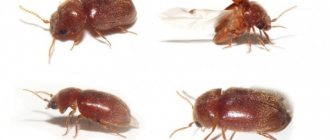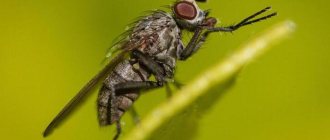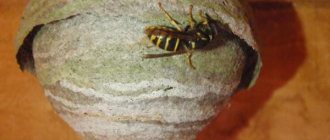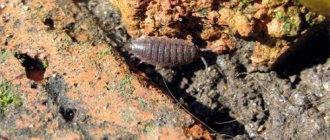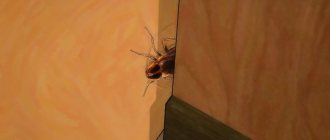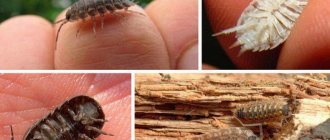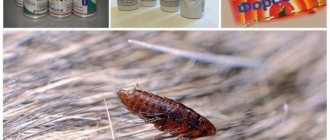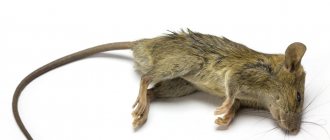Residents of city apartments rarely encounter bark beetles, but for owners of dachas and private houses this is a common problem. It is quite difficult to get rid of the bark beetle, which is due to the rapid growth of the population under favorable conditions. Pests spoil trees on the site, damage wooden floors (floors, ceilings, walls), furniture and interior items. If measures are not taken in time, in a couple of years they will completely destroy housing and all plantings.
The wood borer is a small insect that feeds on wood, destroying its structure. Of particular danger are beetle larvae, which are voracious and capable of eating up to 10 g of wood fibers per day.
We have collected the most effective methods and means that will help you fix the problem yourself and save the wooden structure. The choice of method depends on the scale of the disaster.
Features and danger of bark beetles
The bark beetle is a small insect that feeds on wood. Pests go through several stages of development:
- Eggs . After mating, the adult female gnaws her way deep into the tree, where she leaves the clutch.
- Larva . From the moment the eggs are laid to the next stage, an average of 7-10 days pass. The larvae are small white-transparent worms that are voracious. By eating the sap and fibers of the tree, they move inside the trunk and leave passages behind them.
- Doll . The period of transformation of a larva into a pupa takes on average 2-3 years.
- Adult . The beetle reaches a size of 4-6 cm, the surface of its body is covered with a chitinous shell of dark brown or black color, and there are club-shaped antennae on the head. Appearance may vary depending on the type of insect.
The borer goes through 4 stages of development: eggs, larva, pupa, adult
It is better to start pest control at the larval stage. However, it is quite difficult to find them, since they are located deep in the trees, do not crawl out and are able to withstand temperature fluctuations from −30 to +38 ℃.
Bark beetles are found primarily in temperate regions. Their favorite wood is spruce, fir, pine, cedar, and in the absence of these species, they do not disdain other trees. In this case, preference is given to wood affected by the fungus.
The bark beetle poses a danger not only to trees in the garden, but also to wooden buildings (baths, houses, sheds, gazebos), as well as pieces of furniture
The main danger of pests is damage to trees or wood products. They eat wood, breaking through passages and spreading fungal spores through them, which accelerates the destruction of the tree from the inside. Therefore, a tree that is intact and healthy on the outside may turn out to be rotten on the inside. This is especially dangerous for load-bearing structures and supports, which can collapse at any moment, causing significant damage.
Bark beetles do not pose a danger to humans. They do not bite, do not transmit infections and do not provoke allergic reactions. But for houses and furniture made of wood, small bugs can be destructive.
How to protect your home from bark beetles and what to do if you cannot avoid infection
Harm from bark beetles
Bark beetles do not pose any danger to humans, as do mosquitoes, flies, bedbugs or lice. The living environment of these insects is trees and all materials made from them. Grinders hide in the bark of a tree and, gnawing through all its layers, get to the center. There, the females lay eggs, which within a week become larvae and cause irreparable damage to the wood.
In 24 hours of the bottom, the larva is able to absorb about 10 g of wood.
In winter, the larvae fall asleep and can withstand air temperatures down to – 30 o C. The interesting thing is that they can remain in this mode for three years. They then develop into pupae and adult beetles. And the reproduction process continues as usual.
Adult bark beetles are able to move to neighboring trees, expanding the boundaries of their existence. Wooden structures become victims of woodworms: houses, sheds, bathhouses. Wooden houses damaged by bark beetles eventually collapse and the wood turns into dust. Damage to load-bearing structures is unsafe, because in this case the house may collapse. Woodworms have another negative property: they are carriers of fungal spores, which accompany the formation of mold, which is very harmful to humans.
Very often, bark beetles infest wood stored in warehouses. Therefore, cases where contaminated material is used in the construction of houses are not alone. To avoid this, it is necessary to adhere to wood storage standards.
Before purchasing wooden building materials, conduct a thorough inspection. Small holes and winding paths in the material should alert you. This is the result of the work of bark beetles. Unfortunately, untreated logs are difficult to inspect because defects are not visible on the bark.
Therefore, experts recommend inspecting log cuts for damage.
The wood must be dry, since bark beetles feed on tree sap; the more sap there is in the material, the higher the chance of infection by insects.
When purchasing a wooden house, first of all inspect it for traces of bark beetles. It is very likely that the owners are selling their homes precisely because of this.
To protect your home from this pest, be sure to treat wooden houses against bark beetles with antiseptic substances 2-3 times, every 7-10 days. For this purpose they use: Antizhuk, Wood Healer, Ekolan-41, etc. Premises not intended for human habitation are most often treated with recycled machine oil.
How to recognize a bark beetle
These insects are nocturnal, hiding inside solid wood. In this regard, it is difficult to notice, but it is possible if you pay attention to the following nuances: carefully inspect wooden floors, walls, pieces of furniture, etc. Small holes of 1 - 2 mm indicate that there is an infection. Gnawing through tunnels, bark beetles leave white or yellow dust. It can be found near baseboards and on the floor.
Night is exactly the time of day when you can hear the bark beetle “crunching” on wood. These sounds resemble the passage of a clock.
In ancient times, the sound of bark beetles grinding a tree was taken as a bad omen. It was believed that one of the inhabitants of the house would die. Nowadays, no one believes in superstitions, but there is a grain of rationality in this sign. After all, damaged wooden structures can collapse at any moment, which can be fatal. In certain countries, the sound made by bark beetles is still called the “death clock.”
Causes and signs of appearance
The main reasons for the appearance of bark beetles in wooden houses:
- high humidity, which leads to wood damage by fungus;
- improper or insufficient wood processing;
- use of low-quality materials for construction;
- purchasing wooden furniture made from infected wood.
It is almost impossible to identify pests in a residential area, since they settle deep in the wood, and crawl out only when the raw material becomes unsuitable for life and food. However, if you are careful, you can notice the first signs of pests. Upon careful examination, small holes (up to 2 mm in diameter) and remains of brown flour (recycled wood) are found, and rustling noises are heard at night.
In the garden, a visual inspection of the trees will help determine the presence of pests - they begin to dry out, and the passages of the borer can be seen under the bark. You can see what it looks like in the photo below.
The appearance of bark beetles is indicated by the presence of small holes and passages that are visible under the bark of trees or on affected wooden products
Preventive measures to combat bark beetles in homes
You can stop the appearance of bark beetle in a wooden house using preventive methods. It is better to start fighting it in the area adjacent to the house and garden.
- To clean the forest and reduce the number of harmful insects, attract birds, install feeders and birdhouses. Recognized “forest orderlies” improve their own habitat, getting rid of unwanted neighbors and human habitation.
- Timely cleaning of the forest from dead wood, fallen trees, stumps, and dead branches will significantly reduce the number of convenient habitats for pests. It is necessary to regularly thin out the crowns, remove and take away cut branches, and clean the area of fallen leaves in the spring. All these places are attractive for insects that feed on wood.
- As a preventive measure, treating tree trunks with a solution of slaked lime is good. For 1 part lime, take 3 parts water, mix gently and wait 2-3 hours for the reaction to occur. This phase is characterized by heating and active bubbling, then hissing. When the solution “calms down”, stir again and begin processing. The treatment should be carried out with glasses and gloves. Whitewashing is done with a simple paint brush. Bleached trunks are protected from the risk of bark beetle infection.
- At the end of flowering of the fruit trees, the mass emergence of the beetle begins. To destroy adult individuals, spraying with Lepidocid and Boverin is used. They kill pests, but do not cause damage to plantings, and are safe for the soil. Repeated spraying is carried out after a couple of weeks.
- One of the methods of prevention is regular inspection of tree trunks on the site and the surrounding area to detect woodworm passages and holes in the trunk. The first signs of damage are a reason to treat with insecticides. Biologically active preparations of targeted action are designed to combat specific types of insects. They are safe for birds and pets.
- Large affected areas require more effective means. Chemical agents have sufficient power and paralyzing effect on pests. The drug Candifor Extra has a penetrating effect into the thickness of the wood and is destructive for insects that have climbed deep into the thickness of the trunk. The clipper preparation is intended for processing bark. It attacks the digestive system of pests while devouring wood.
- If the tree is significantly damaged, it is better to give up trying to save it. The site will be greatly benefited by cutting it down, uprooting the stump and burning wood debris.
As a preventative measure, it is necessary to monitor the humidity in your own home, since the bark beetle prefers to settle in damp wood. A hygrometer and a household dehumidifier will help regulate the microclimate. If the walls are damp, heat the house, use a heater or heat gun. A fan set to heating mode will also help. Ventilate the room regularly by opening all doors and windows wide to allow air movement. A musty, moldy smell can also indicate high humidity.
If the attic or attic is filled with junk, old furniture, and wooden rubbish, this creates an additional risk of bark beetle infection. You should clean regularly and get rid of old and unnecessary things.
Coating with varnish and paint will help protect wooden surfaces from bark beetles. To care for varnished surfaces, special polishes are used. They also contain substances that repel insects, and wax seals small cracks. In addition, after treatment with Gloss or Polish, wooden elements acquire an attractive appearance.
If varnishing or painting is not provided for the design of a wooden surface, preventive treatment with sodium fluoride can be carried out. For 10 liters of hot water, take 250 g of dry product and mix. When the liquid has cooled, soak a soft cloth or sponge in the solution and wipe the wooden structures. If you find holes in the tree, you need to take more active action.
Mechanical methods of pest control
A radical way to get rid of bark beetles is to dismantle and burn the affected wood. This method is used in exceptional cases, as it has a number of disadvantages:
- damage to the integrity of wooden structures is required;
- it is impossible to be absolutely sure that the remaining elements of the structure are not affected by pests;
- effective only at the initial stage of bark beetle reproduction.
XILIX Gel
XILIX Gel gets rid of all wood pests. This professional biocide effectively removes mold, mildew, insects, and larvae. It also treats affected areas of houses and forms effective protection.
How XILIX Gel works
The drug protects and rids wood of parasites. The white gel-like substance acts as an insecticide. Contains permethrin (0.51%), which resists sucking and leaf-eating pests. Eliminates organisms resistant to organophosphorus insecticides. The drug is dangerous for cats .
A gel with significant penetration properties penetrates deeply to a distance of 10 cm from the surface and does not drain. Kills adult insects and larvae. Propiconazole in the composition prevents the appearance of mold and fungi. Fungal spores do not settle on the surface of the wood product. Due to the thixotropic formulation, the drug acts without loss of properties in a thick wood layer. The number of passes to obtain a therapeutic effect is reduced.
Benefits of the gel
XILIX Gel is an innovation in methodological approaches to getting rid of tree pests. Advantages:
- resistance to mold, mildew, wood pests, including larvae, eggs;
- deep penetrating ability due to a special formula;
- Possibility of use outside and inside housing;
- long-term preservation of the effect (there will be no secondary infection for 10 years);
- safety for humans, the environment and pets (excluding cats);
- suitable for all wood species;
- does not change the color of the wood, does not leave stains;
- no smell;
- acceptable cost.
The best place to order XILIX GEL treatment is from. The specialists passed prof. training and have all the necessary equipment to provide the highest quality services.
Preparation for the procedure and application of XILIX Gel
Before processing, you need to consider: the use of XILIX Gel requires professional assistance, since special equipment is used. Xilix Gel is applied by spraying with a painting unit with a hydrodynamic pump:
- GRACO;
- WAGNER;
- TITAN.
First comes the preparation of the wood. It is cleaned of dirt and dust. Old paintwork or other coatings are removed. The wood is sanded to remove loose layers using professional equipment. Damaged wood elements must be replaced before applying Xilix Gel.
The gel contains a fluorescent pigment, so you can monitor the quality of the coating. The pigment appears about a month after application of the drug. XILIX Gel is used at temperatures above 0 °C, wood moisture content is not more than 25%.
The product is applied by applying one to three layers to the wood, depending on the thickness, type, and humidity of the substrate under low pressure (maximum 5 bar). In areas where application of the gel is difficult, parenteral injection of the drug into the drilled holes is carried out to ensure complete impregnation. Spraying is important for wood with a significant diameter or wood that is difficult to access from several sides.
Working diagram:
- Inspect the facility, carry out calculations of chemical consumption.
- Prepare part of the base for application.
- Apply the drug.
- Check the results.
Xilix Gel for bugs and fungus
The drug is used for prophylactic or therapeutic purposes. For prevention:
- insect eggs die because they are in the upper woody layer and are the first to be affected by the drug;
- females are unable to lay eggs;
- the larvae present cannot resist the action of the drug and die;
- fungal spores do not settle, do not multiply, and do not survive.
During treatment:
- the drug prevents the formation of mold and fungi;
- The product kills various insects, adults and larvae. The drug is quickly absorbed, penetrates 10 cm from the surface or more, and effectively fights even pests hidden deep inside.
XILIX Gel is an active substance manufactured by a manufacturer from France. Sold in the form of a gel, its purpose is to treat wood to get rid of insects, mold, and mildew. There are no similar preparations in the Russian Federation with a similar formula, thanks to which the gel penetrates into the deep layers of wood. A 10-year guarantee on the effectiveness of the treatment is provided. This is an effective drug for treating wood and preventing destruction due to pests.
XILIX Gel
Fumigation
Fumigation using phosphine or magtoxin gases will help control pests. The poisonous gas penetrates the passages of insects, destroying eggs, larvae, pupae and adults. Carrying out aeration should be entrusted to specialists in order to achieve maximum results in the fight against parasites and avoid poisoning and other negative consequences.
During fumigation, the outside of a wooden house is covered with a special dome, which prevents the spread of gas throughout the area and increases the efficiency of treating the structure.
Disadvantages of fumigation:
- high price;
- the need to attract specialists;
- high toxicity of the gas used;
- After etching, degassing is required to disintegrate the phosphine particles.
Pheromone trap
Mechanical methods of influence include a pheromone trap. This biological method is environmentally friendly, safe for people and animals. The trap is a plastic structure containing a pheromone inside. The beetles flock to the attractive aroma, hit the partition and fall to the bottom of the container, from where they cannot escape. The principle of operation of the pheromone trap is described in detail in the video:
It is important to understand that a pheromone trap is effective for catching only adult individuals, and it can also work the other way around - attracting insects from other territories that will not fall into the trap, but will settle in trees, destroying them.
Microwave devices
Devices emitting high-frequency electromagnetic waves will help fight pests in a wooden house. The microwave emitter heats the wood to high temperatures (+60 ℃), which effectively destroys insects at different stages of development. This method is safe for the building and residents, but requires compliance with certain safety measures, so it is better to entrust the work to specialists.
Confidor Extra
A broad-spectrum insecticide that helps get rid of several types of insects, including bark beetles. Long-term protection, a method of controlling pests that feed on wood through the gastrointestinal tract.
Advantages:
- used not only on trees, but also on garden crops, shrubs, etc.;
- promotes restoration of damaged parts of the trunk;
- acts deeply;
- quickly copes with the task, from 2 to 48 hours;
- does not wash off in the rain, works for a long time.
Flaws:
- works only on those beetles that feed, has no effect on larvae or sleeping ones;
- toxic, protective equipment required.
It is prohibited to spray chemicals near the residence of dogs, cats or bees. For affected areas, a single treatment of the wood is sufficient. Release form: water-soluble granules (WG). It works on the principle of contact-intestinal influence. For 10 liters of water, 2.5 ml of the drug; if there are a lot of beetles, increase the concentration by 2 times. Initially, dissolve the granules in a small amount of water, mix thoroughly, and add the rest of the liquid.
Treats affected areas, destroys mold and mildew. It is valid all season; before spraying, protect the soil and everything nearby. It is safe for humans, but can harm beneficial insects, underground inhabitants and pets.
According to buyers, it does its job well and is safe for plants. Suitable as a way to combat severe cases, even in hot weather. One treatment is enough for the whole summer. Effective against bark beetle and most types of insects that eat wood.
The use of folk remedies
Folk remedies will help you get rid of bark beetles in a wooden house. They are used for treating wood with a sponge or spray at home, as well as for filling bark beetle burrows. Effective recipes for killing beetles:
- mix kerosene and turpentine in a ratio of 1:3. Saturate the outside of the wood with the resulting product and inject it into the tunnels using a syringe;
- combine naphthalene, tar and turpentine in a ratio of 1:1:3. Mix all the ingredients and introduce the mixture into the holes left by the bark beetles;
- melt the paraffin and add crushed rosin to it (proportion 5:4). Bring the mixture to a boil, add vegetable oil and simmer for another 2 minutes. Introduce the cooled mixture into the insect passages.
After treating the wood, fill all holes with silicone or acrylic sealant. This will block the escape routes and destroy the insects that managed to survive the first stage of persecution.
To protect against bark beetles, the wood should be covered with hot drying oil. It is used not only for external treatment, but is also poured into insect passages to destroy them.
Antibug Neomid
A product for controlling pests that damage the wood of buildings, structures and garden plantings. It affects not only bark beetles, but also other insects.
Advantages:
- preserves the integrity of the remains of the trunk;
- after that the surface can be painted, whitened or treated with fertilizers;
- penetrates to the core of the trunk, destroys accumulations of larvae;
- suitable for preventive spraying;
- houses are treated inside and out.
Flaws:
- contains ammonia, work in a respirator, headaches are possible after completion;
- It is recommended to ventilate the room for 4-6 hours.
Before application, clean the surface from dust, dirt and coatings that block the penetration of the composition (varnish, paint). Remove affected areas that cannot be restored. Cover the surface nearby with protective material; do not treat it.
Anti-bug is sold in concentrated form; to start working, dilute it with water in a ratio of 1:4. The affected area is covered with the composition, and the liquid is injected from a syringe into the grooves left by the bark beetle. Consumption 200-300 g per m2, apply to horizontal and vertical surfaces with a brush or synthetic roller. For prevention, 150-100 g is enough. Repeat the procedure 14 days after the initial treatment.
After the beetle chews through the tree, it begins to rot. The product acts as an antiseptic and blocks the formation of mold. Neomid destroys adult insects, their larvae, and prevents the emergence of a new population.
According to reviews, it has a specific but tolerable smell, dilutes well, and does not foam. It is applied quickly to a dry surface and is immediately absorbed. The action lasts for a season and wears off in 2-3 days. After treatment, beetles crawl out of the holes and die, more effective than folk remedies. Experienced gardeners advise applying it as a preventive measure to protect fruit trees.
Use of chemicals
Chemicals help remove the bark beetle by destroying adults and larvae. With their help you can process a large number of products, trees or an entire building. However, you should be careful when working with insecticides, as some products may be harmful to animals or people.
The table contains the most effective chemicals that will help cope with woodworms:
| Name | Active substance | Mode of application | Advantages | Flaws |
| "Bi-58" | Dimethoate | The solution is used for spraying plants and wooden buildings | Destroys bark beetles, their larvae and other beetles | To achieve the effect, re-treatment is required after 3 weeks. |
| "Confidor Extra" | Imidacloprid | The solution is prepared according to the instructions, then it is used to process wood products (furniture, sections of beams, panels, etc.) | Effectively fights adult insects and larvae | Repeated processing required |
| NEOMID StopBeetle | Synthetic pyrethroid | The drug is diluted with water in a ratio of 1:4 and is used to impregnate wooden buildings | Suitable for external and internal processing, penetrates deep into wood, does not interfere with further work with wood | Re-processing is required to maintain the effect. |
| "SenezhInsa" | Stabilized aqueous composition of active substances, including technological and functional components | The solution is used to impregnate wood before use in carpentry or construction. | Penetrates deep into the layers of wood, due to which it retains the ability to repel beetles for a long time | Gives untreated wood a greenish tint |
| "Clipper" | Bifethrin | The product is sprayed on trees on the site, pieces of furniture, and wooden floors. | Good penetration | Re-processing required |
Rules for using pesticides to kill pests:
- Read the instructions on the package.
- Take proper safety precautions - wear gloves, a protective suit, a respirator.
- Follow the instructions to avoid poisoning and other consequences.
- After treatment, take a shower.
If none of the presented methods of combating bark beetles brings the expected result and the pests do not leave the house, use the services of exterminators. To combat insects, they use chemicals and mechanical methods.
BI-58 New
An improved version of the insecticide BI-58 to combat beetles that feed on plants. The action is based on the substance dimethoate. After coating, the product is absorbed into the bark and penetrates into the deeper layers. Insects eat them, are poisoned and die, BI-58 paralyzes the nervous system. The new composition of the drug lasts longer, and its effectiveness does not depend on weather conditions.
Fruit trees that are traditionally grown in Russia are resistant to the effects (apple, pear, plum trees), and are suitable for shrubs (currants, raspberries, gooseberries). Also used for gardening, indoor plants, and in greenhouses.
Advantages:
- applicable not only for bark beetles, but also for other types of parasites;
- safe for trees;
- acts quickly;
- harmless to people and pets;
- stimulates growth, helps to recover from destruction;
- used simultaneously with other pesticides.
Flaws:
- not suitable for hard water;
- Processing should be carried out during the growing season, at a temperature of at least +12 degrees.
The drugs are produced in capsules, 1 piece per 10 liters of water. The exact dosage is written on the package, depending on the crop being treated. For a garden, 1.6-2 liters of ready-made solution per 1 hectare. Use the solution immediately; storing is not recommended. Use clean water; hardness affects performance. After the start of flowering, the plants are prohibited from being processed; the composition negatively affects future fruits. Cannot be used after the first frost; the likelihood of defeating parasites is reduced several times.
Please note: apply only on the bark, the leaves suffer and die from the substance, follow the dosage.
Buyers recommend it on the positive side, it helps get rid of bark beetles in a short time. It works for a long time, a maximum of 2 applications per season. The smell is specific, unpleasant, the pheromone trap repels parasites. Inexpensive, convenient packaging. It is allowed to mix with fungicides and other insecticides (except for the mixture with AZOFOS). It is not recommended to use it near bees; when spraying, use a respirator and gloves.
Prevention of the appearance of bark beetles in a wooden house
In order to preserve a wooden building and avoid the appearance of a grinder, pay special attention to the selection and preparation of wood:
- check the boards before purchasing, inspect them for small holes or passages;
- choose dry wood, since wet wood contains sap that attracts bark beetles;
- when purchasing logs, examine the ends and make sure there are no tunnels;
- treat the material with insecticides and cover with a protective composition;
- Avoid high humidity in the room, prevent wood from rotting and fungus from spreading.
To build a house, choose high-quality dry wood without fungus and signs of the presence of bark beetles.
When buying a wooden house, pay attention to the condition of the wood and the presence of infection, and when moving into a new building, first carry out antiseptic treatment. For prevention, use the chemicals “Ecolan”, “Antizhuk”, “Wood Healer”, etc. The treatment should be carried out three times with an interval of 7 days, so that you can live in the room without fear.
Assess the condition of wooden furniture before purchasing, as unscrupulous manufacturers may use contaminated raw materials for production. After such a product gets into the house, there is a danger that bark beetles will begin to look for new sources of food, attacking other wooden objects.
An integrated approach, which includes the use of mechanical, folk and chemical methods, will help you get rid of the bark beetle in your home or summer cottage. In difficult cases, use the services of exterminators to save your home and avoid its complete destruction.
Prevention of bark beetle infection
The best method of controlling bark beetles in a wooden house is prevention. What kind of wood does not infest the bark beetle? There is only one answer - treated with special bioprotective substances. Prevention should begin before construction begins, when choosing lumber for building a house:
- you should ask the supplier about the availability and processing method;
- carefully check logs and boards for exit holes;
- for prevention, wooden surfaces should be periodically treated with an insecticide and coated with protective substances;
- remove contaminated parts of wooden parts in a timely manner;
- prevent wood from rotting and moisture accumulation;
- Furniture protection is provided by bio-impregnation. Furniture varnish prevents beetles from penetrating into the wood, and the remaining larvae and eggs will die.
A log house is popular due to its environmental friendliness, low thermal conductivity, and availability of the material. In order for the building to please the owners for many years, timely treatment against the bark beetle is necessary, and in case of infection, you need to know how to remove the bark beetle.
The danger of bark beetles
In special bags on their bodies, females carry fungal spores, which also serve as food for them. And on the surface of their bodies there may be bacteria - pathogens of diseases that are dangerous not only for plants, but also for humans.
In addition, the lack of reaction to the appearance of larvae and adults in the garden or in the house can lead to such unpleasant consequences as damage and destruction of furniture structures, stairs, and rafter systems. The subspecies known as the “typographer” is especially dangerous, the invasion of which is noted in the Moscow region and in the northwestern regions of Russia (Vologda, Yaroslavl, Novgorod regions). Its larvae are voracious, show incredible activity and feed mainly on coniferous trees.
How to protect your house from bark beetle?
At the first sign of a pest, home remedies and available chemicals are used. If the spread of the beetle cannot be stopped, you need to call specialists who have stronger substances in their arsenal that can reliably cope with the population.
Effective remedies for the borer beetle in a wooden house
Ways to protect wood
Removing a pest is more difficult than taking care of preventive treatment with antiseptics and insecticides. A small number of arriving beetles can be destroyed with ordinary Dichlorvos or Karbofos. But if there is a colony of woodworms, it is more difficult to get rid of them.
Impregnation
Advantages of protecting a building using impregnation:
- The product penetrates deeply into the structure of the tree.
- You can choose a product without toxins.
- The beetle-impermeable film on the surface of the material preserves the wood’s ability to conduct air.
- The substances are relatively inexpensive.
For effective impregnation, for example, Neomid 100 is suitable, which, under the manufacturer’s warranty, protects lumber for 7 years after one treatment.
Treatment with chemicals
You can treat trees or wooden buildings with insecticides. A sprayer is used for this. For these purposes the following is used:
- Clipper - short-term treatment for bark beetle for 3-4 weeks.
- Antishashelin is a long-acting injectable drug.
- BI-58 – kills pests of any age, 2-3 treatments are needed.
- Confidor Extra – valid for 30 days.
- Aktar is an insecticide of contact intestinal action. Suitable for protecting wood in the soil, plants, potatoes.
Chemicals are usually used if there are a lot of beetles. When using drugs inside a house or apartment, for example, on flowers or floor beams, floors, safety rules should be followed.
Folk remedies for fighting bark beetles
The bark beetle can also fly into a brick house and have larvae in wooden floors, ceilings, or ornamental plants. You can use traditional methods:
- Drying the room and heating accessible surfaces to a high temperature.
- The use of oils for filling insect passages - vegetable, linseed or machine.
- Inject kerosene, gasoline, diesel fuel into the channels with a syringe.
Attention! Petroleum products are flammable and toxic in large quantities.
Safer mixtures for pouring into holes left by insects:
- heat drying oil or plain water to boiling water and scald the surface, getting into the passages;
- mix turpentine and kerosene in a ratio of 1:3, spray the wood;
- Dilute soap and carbolic acid in water and treat the surface;
- coat the wood with varnish.
Professional methods of treating buildings
Disinsection is the name of professional treatment for beetles. Companies provide a 100% guarantee of insect destruction.
In addition to medications, specialists use high-frequency electromagnetic waves (microwaves), with the help of which the structure heats up to 60 degrees. This results in the elimination of the entire colony, including eggs and larvae.
For each case, specialists select the processing method and composition of chemical and biological mixtures, depending on:
- wood species;
- degree of infestation;
- temperature, precipitation, time of year.
For example, in some cases special devices are used - fog generators. They create a consistency that can easily penetrate the channels made by pests.
Specialized preparations for killing insects
There is always a danger of restoration of the bark beetle population if you use ineffective or expired drugs.
When choosing, you should pay attention to the description of the product. Usually it indicates how to dilute the poison.
Experts recommend the following substances:
- Vitalizer NV-101 is a Japanese natural product based on an extract of coniferous trees. The substance is intended for injection into coniferous plants and lumber.
- Bifenthrin is a pesticide and insecticide that affects the biology of insects of any age.
- Krona-Antip is a contact-intestinal substance against stem pests.
Pheromone traps
You can defeat pests using pheromone traps. For this purpose, biotechnical methods are used - physical stimuli and chemicals as pathogens and hormones.
Insects can be poisoned within a radius of several kilometers. The downside of the product is that 20 m from the trap a densely populated area with bark beetles is formed, the trees in which must be destroyed - burned or cut down along with the arriving beetles.
Important! Pheromone traps should never be used in summer cottages.
Fumigator
A type of independent method of combating bark beetles in the garden is a fumigator. If you regularly use electrical appliances such as Raptor or Fumitox in large quantities (especially from April to July) or burn the required number of fumigator coils, you can create fairly reliable protection against pests.
Most often, this remedy is used as an auxiliary. It is used during the period of highest insect activity.
Freezing
All families of wood-boring beetles can be killed by frost. If the outside temperature is below minus 25-30 degrees Celsius, then the bark beetle is removed by greatly cooling the room. However, this method of pest control is not reliable, since it is difficult to freeze out insects in the depths of a log house.
Drying wood
Pre-drying the wood helps to destroy the beetle in lumber for a private building, provided that the boards can be heated to a temperature above 65 degrees for 30 minutes. This method is limited for use by the size of the wood.
Exposure to electromagnetic waves
One way to heat wood is to use ultrahigh frequencies. Special generators create a microwave field that increases the temperature, primarily inside lumber and wooden structures. With uneven exposure to microwave waves, fires and charring are possible.
On a note! The peculiarity of this method is that the material being processed must not contain metal elements - nails, staples, etc.
Mechanical destruction
The log can be replaced with another during the construction phase if rotting or beetle damage is noticed. Sometimes it is impossible to replace an element in a completely finished structure. In addition, this does not guarantee that pests are absent from adjacent areas of the walls, roof or floor.
What kind of pest is the bark beetle?
There are more than 140 species of these beetles in Europe. The largest are 0.8 cm. The total in the world is 750. The length reaches 1.5 cm. Their varieties (subfamilies) are pine beetles or sapwood, named after the damaged areas of plant tissue.
The distribution of pests corresponds to the geographic location of tree species that are preferred by a particular type of insect. The bark beetle has to be fought everywhere, especially in forest areas.
Biological features of bark beetles
Beetles live in families, which are divided into monogamous (one male and one female) and polygamous (several females). In each type of family, the female gnaws her own uterine passage, the structure of which is different. Based on the cut of the plant and the structure of the burrows, experts determine the type of pest.
The insect frees the gnawed canals from drilling flour - the remains of wood, the presence of which in a tree or structure is the first sign of the appearance of the beetle and the need for treatment against the bark beetle.
Appearance and life cycle
Most individuals are 3-4 mm long. Insects are characterized by four-jointed legs and club-shaped antennae.
In the subfamily of bark beetles, on the slope at the end of the abdomen there is a depression with tubercles or denticles along the edges - a “wheelbarrow”, with the help of which the beetle removes drilling flour. The top of the head is covered by a hood – the prothorax. The latter is absent in pine beetles.
They have elytra curved down at the end of their body, hiding their abdomen at the back. In sapwood, towards the top of the underwings, the abdomen is sloping from the hind legs, and the elytra are almost straight.
All bark beetles have whitish colored larvae with a curved body and a yellow head.
The beetle of the bark beetle subfamily lives on trees in the areas:
- surface layer of sapwood;
- cambium;
- lube;
- bark.
The female gnaws an entrance canal in the bark and sharpens the uterine passage, in which she lays eggs on the sides. The larva emerges from the egg and, in turn, gnaws the passage for itself. At the end of feeding, the larva settles into a pupal cradle, where it pupates.
A new young insect, emerging from the pupa, makes another hole in the tree and flies out. In addition, some pests dig into additional passages - mating shelters and ventilation ducts.
What does it eat and how does it reproduce?
The fight against emerging bark beetle is relevant not only for fruit trees, but also for conifers. More than 60 species of insects focus on them.
Some representatives of these beetles live on plant roots. Some prefer birch bark or thick bark. Small species feed on young trunks just under the bark. The presence of large amounts of proteins and sugars in wood contributes to the rapid growth of larvae.
Before fertilization, female beetles produce special substances - pheromones, which attract insects.
An optimal safe environment and temperature regime for the development of eggs and larvae is formed inside the tree.
What damage does the bark beetle cause to trees and wooden buildings?
The greatest damage to wood is caused by larvae. Before pupation, within a month of development, only a few larvae are capable of destroying an adult plant.
Wooden buildings on the site - a house, a barn, a bathhouse - are also afraid of the beetle. If an insect appears in load-bearing structures, the building may settle, tilt, or simply collapse.
In addition to making passages, insects carry fungal spores, which accelerates the process of rotting and destruction. A few scratches on the surface of a log or board that still looks good on the outside is a sign that the wood may be more seriously damaged from the inside.
Features of bark beetles
The bark beetle is a small representative of the Coleoptera family, the main eater of wood. Having seen it, it is difficult to guess that such a “bug” can cause so much harm, but in fact it is capable of destroying entire hectares of coniferous forests.
So, the bark beetle is an insect whose length is less than 10 mm. Its color ranges from dark brown to black, but there are also brighter representatives.
All types of bark beetles pose a threat to a living tree: both those that eat the trunk and those living in the roots. For the walls and ceilings of a wooden house, only the first type is dangerous, and not only adults, but also larvae settle in the thickness. The bark beetle's entire life is spent inside a tree, where it feeds and reproduces, rarely appearing outside, and therefore is capable of completely rendering the structure unusable.
Preventive measures
In order to protect your garden from the bark beetle, you must not forget about preventive measures:
- Systematically inspect the trees, which will help you detect infested pests in a timely manner.
- Do not forget about the agrotechnical rules of garden crops, namely, properly water, feed, prune, tie, etc.
- Carry out sanitary and hygienic measures in a timely manner: cut off branches that are dried and damaged by disease or frost, as beetles can settle on them. You also need to clean the bark in a timely manner, disinfect and cover frostbites and wounds, whiten the trunk and base of skeletal branches with lime every year, clear the area of fallen leaves, and dig up the soil in the tree trunk circle.
- Regularly treat plants with organic means, namely: coat the trunks with manure mixed with slaked lime, or a mixture of humus and clay.
- Installation of bait logs on the site (see above).
- Attracting black woodpeckers to the site, which are natural enemies of these pests.
- Systematic use of complex products that are capable of exterminating several types of pests that harm trees.
Remember that it is very difficult to get rid of the bark beetle, and sometimes the pest wins in this exhausting and lengthy struggle. Therefore, do not neglect preventive measures and do not forget to regularly inspect the garden.
How to get rid of bark beetle on trees
How can you tell if a tree is infected with a bark beetle?
Very often, the bark beetle does not settle on healthy trees, but on weakened and diseased ones. The fact is that thanks to his unsurpassed sense of smell, he is able to determine which tree is sick or weakened. In the garden, such a beetle can settle on fruit trees whose surface bark has cracks or wounds on the trunk and branches, as well as on seedlings recently planted in a new place. This beetle can also harm trees whose root systems are severely damaged.
You can tell that a bark beetle has settled on a plant by small holes in the bark, while resinous traces can be found on coniferous trees, and streaks of gum on fruit trees. Plants that attract woodpeckers deserve special attention, because this pest is most often found in them.
Inspect the surface of the barrel carefully. If you find drill flour (small sawdust) on it and at its base, then this is a sure sign of the presence of a bark beetle. If the color of the flour is brown, then this means that the beetle has only gnawed through the bark, and if it is white, it means it has reached the wood. During the last stage of infection, the crown of the tree dries out, and its leaves or needles fly off. A tree from which the bark falls off in pieces is dead.
Bark beetle on an apple tree.
